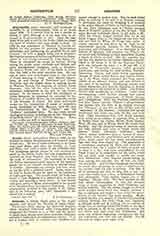

Arialdo, Saint, martyred at Milan in 1065, for his attempt to reform the simoniacal and immoral clergy of that city. He was of noble extraction, b. at Cutiacum, near Milan, and after his studies, at Laon and Paris, was made a canon in the cathedral city. For inveighing against abuses he was excommunicated by the bishop Guido, but was immediately reinstated by Pope Stephen, who bade him continue the work of reformation. He succeeded in having the bishop excommunicated because of his repeated lapses, but a riot ensued, resulting in serious injury to Arialdo. Previously an attempt had been made on his life with a poisoned sword. Later, when on his way to Rome, he was set upon by the emissaries of Guido and slain. Ten months after, his body was found in Lago Maggiore in a perfect state of preservation, and emitting a sweet odor. It was carried with great pomp to Milan, and exposed in the church of St. Ambrose from Ascension to Pentecost. It was subsequently interred in the church of St. Celsus, and in the following year, 1067, Alexander II declared him a martyr.
T. J. CAMPBELL

